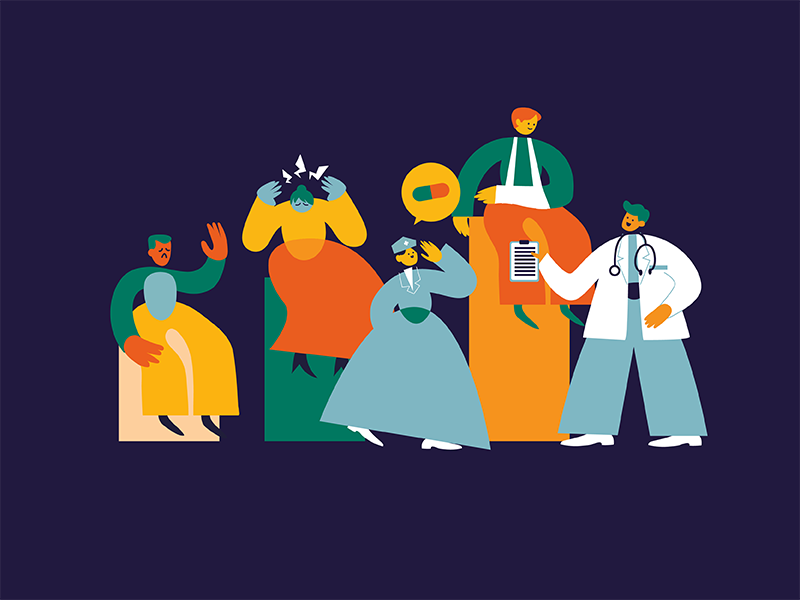The communication gap in patient education is more than jargon barriers. It’s also about emotional barriers, perspective barriers, and other noises that affect patient education. Before jumping right into a new patient education campaign, we want you to slow down and go back to 8 types of communication barriers in healthcare. Though most of them are basic communication knowledge, it gives you more perspective on the “gap” and brings new ideas for your next campaign.
8 Types of Communication Barriers in Healthcare
1. Physical and Environmental Barriers
When you launch a healthcare event for patients, many physical and environmental factors limit patients from receiving the message.
- Noise: One of the primary barriers that arises at the transmission level is noise. This often occurs when patients access healthcare information through telehealth services or TV broadcasts. Poor signal quality during phone consultations and TV broadcasts can disrupt patients’ ability to absorb crucial information. Using safety video production in healthcare communication can help address these challenges, ensuring that key messages are clear and accessible in various environments.
- Time and Distance: When our marketing lead shared her experience in one of her healthcare communication campaigns, she said: “The hardest part when conducting an offline healthcare event is to set location and time smartly because we need to ensure as many patients as possible join the event.” Also, we need to consider the time differences between the two countries.
- Wrong choice of medium: Sometimes, healthcare knowledge isn’t the issue—it’s the way we convey it. Delivering information through the wrong medium can confuse patients, especially when reading a detailed prescription without visual aids. In such cases, animations can be helpful. For instance, medical device animation can simplify how devices function, showing patients how to use them correctly and understand their benefits. Similarly, an animation explaining medication or symptoms visually can make complex concepts easier to grasp.
In the video below, F.Learning uses medical whiteboard animation to explain different symptoms of migraines so patients understand the root cause of their health issues. We also choose a viewpoint of patients’ daily lives so they can see the migraine from their social perspective.
- Message design: The most challenging part of communicating with patients is controlling how patients think about your message. Thus, ensure your message is under a strict proofreading process and avoid wrong word choices, jargon, and complex words.
2. Physical or Biological Barriers
How do you talk to Alzheimer’s patients? Talk slowly, and if needed, educate their family members. For patients with HIV or disabilities, sharing real-life stories can be impactful. Emotional control is essential when working with individuals who have specific physical or mental health needs.
Nuances in communication can make all the difference – sometimes, a simple adjustment in format, like changing text-based content to podcasts, better accommodates those with poor eyesight. Additionally, incorporating mental health cartoon images or other thoughtful visuals can make content more relatable while showing sensitivity and empathy to avoid offending or alienating any audience.
3. Language Barriers
What is a good start to educating patients effectively? The answer is choosing the right healthcare information. Removing language barriers is the priority before you want to remove communication barriers in healthcare. At F.Learning, we have worked with many healthcare clients to realize that we just capture a tiny nuance of language barriers – the healthcare jargon. The language barriers in patient communication have 3 angles:
- Misinterpretation of words: Cholesterol is bad, eating before bed causes weight gain, cold weather causes colds, etc. These myths stem from misinterpretation. Different people understand words differently, and patients are often confused by the range of information sources. By using the right channels, tools, content formats, and methods, eLearning video production companies can help set a clear context for delivering consistent healthcare messages.
- Medical jargon: Since most patients lack a medical background, healthcare jargon can be a significant communication barrier. For example, terms like “G55.3” in a diagnosis can leave patients confused. In these cases, a short explainer video or medical product animation can bridge the gap, providing a clear visual representation of complex medical products or procedures. This method simplifies communication, helping patients better understand medical devices or treatments.
The video below, for instance, explains the differences between Heparin and Warfarin in a way that patients can easily grasp
In 3/2021, F.Learning collaborated with Dr. Manish Chand to make a medical animation about patient education about colorectal cancer and rectal bleeding. This healthcare video is used in the “Colorectal Awareness Month” campaign so that his patients can understand their conditions’ treatment.
- Multiple meanings of words in a different context: Have you ever searched for your symptom on Google? You are a healthcare communication manager, but sometimes a patient as well. We all share a common problem – Dr. Google, even a headache can turn into a brain tumor. A patient education campaign without a clear context causes different uses of different words per need/ message. That’s why you need a healthcare expert on your team to ensure accuracy.
4. Personal barriers
Differences in personal and psychological makeup may create barriers to communication in healthcare between patients and other healthcare providers. They arise from the judgments, emotions, and social values of people. According to Ms. Fasiha Haq, Senior Director of Global Medical Affairs Strategy & Execution at Eli Lilly Canada, doctors and patients have different perspectives about healthcare when they visit each other.
Doctors focus on long-term treatment and root causes, while patients focus on day-to-day healthcare treatment and symptoms. The insight brings a lot of suggestions on how to create a healthcare message from the patient’s perspective. To do that, we need to understand how patients think about the disease.

5. Emotional barriers
If you handle a patient education campaign for a sensitive sexual and reproductive health topic, you will find emotional barriers familiar. Another situation is when patients fear, are anxious, or even sad because the pain prevents them from doing things. In healthcare communication, it’s hard to realize because these moments fester beneath the surface. Utilizing tools like pharmaceutical explainer videos can help address these barriers by presenting complex information in an empathetic and easily digestible way.
6. Socio-psychological barriers
There are 2 types of socio-psychological barriers in healthcare communication. To successfully break the socio-psychological barrier, It’s essential to define the patient persona with a complete description of behavior, characteristics, and background:
- Selective perception: We often see selective perception in fitness or other preventative healthcare topics when patients hear based on their needs and motivations. For example, if you want to lose weight but hesitate to do a workout, you want to listen to a diet solution without exercising.
- Halo effect: Halo effect is when people distrust someone based on their experience, fear, etc. For example, a mom with experience in child care will be more skeptical when consuming healthcare information.

7. Cultural barriers
When talking about sexual health, people from Eastern countries will be more hesitant than Western countries. Patients from underdeveloped areas may be more skeptical about treatment than those from other regions. This is one of the communication barriers in healthcare that impacts patients’ healthcare decision-making.
Cultural barriers also encompass different interpretations of symbols, colors, etc., across countries. For example, when creating a medical procedure animation about childbirth, using culturally appropriate visuals such as attire, patient interactions, and medical settings that align with the target audience’s cultural norms can greatly enhance understanding.
Here’s another video example produced by F. Learning Studio for our client – iHeed. Since the target audience is patients from the Middle East, we use materials relevant to patients’ cultures to create a social context for them.
interested to know more?
Glad you like us! Book a consultation call with us to explore how to kick start your animation project.
8. Channel flow barriers
Channel flow barriers relate to healthcare communication channel strategy because each channel has strengths and weaknesses. When launching a healthcare communication campaign, we can use more than one channel to promote your healthcare message. Using the wrong channel or using too many levels of media may cause misleading in delivering information. Therefore, we ensure that all supporting messages align with the main message to prevent patients from misunderstanding.
Partner with F. Learning Studio to Solve Your Communication Barrier Problems
Expert in Visual Solutions for Patient Education
It seems overwhelming for you as there are a lot of barriers to effective communication in healthcare. At F. Learning Studio, we understand the unique challenges of communicating complex medical information. Therefore, we come up with a unique solution for you, animated videos or animations that are informative, accessible, and impactful. From simple whiteboard animations to stunning 2D productions, we can tailor it to solve your specific communication problems.
Trusted by Leading Companies
With 8 years of experience, F. Learning Studio has built a strong proven track record, working with top-of-mind companies in the field, such as Intelycare, Boehringer Ingelheim, and Simple Nursing. We have supported them in raising patients’ awareness, improving training, and simplifying medical knowledge. No matter what you’re struggling with in healthcare communication, we have something for you.
An Affordable Partner
If you have a budget constraint, don’t worry. We offer a 30% lower solution compared to the UK or US-based studios. However, it doesn’t mean we compromise the price with the quality of the animation. Let’s check our portfolio and see it by yourself.

Conclusion
Addressing communication barriers in healthcare is not just about removing common obstacles. It’s also about creating an environment where patients feel listened to, respected, and engaged in their treatment. With all of the potential solutions we’ve listed in the article, we hope you can find the key to your problem. To make communication a breeze, why not contact F.Learning? With our crafted visual solutions, you can experience a remarkable boost in your patient education!
- WhatsApp: (+84) 378 713 132
- Email: [email protected]
- Fanpage: https://www.facebook.com/f.learningstudio
- LinkedIn: https://www.linkedin.com/company/f-learning-studio/
Read more:




